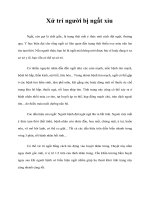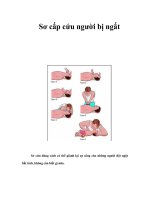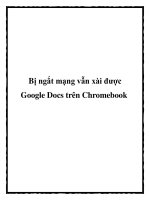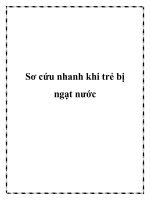Bị Ngất
Bạn đang xem bản rút gọn của tài liệu. Xem và tải ngay bản đầy đủ của tài liệu tại đây (2.33 MB, 95 trang )
Syncope
A Diagnostic and
Treatment Strategy
Syncope: Transient Loss of Consciousness (TLOC)
Syncope
Sudden transient loss of consciousness with associated loss of
postural tone.
Recovery is spontaneous without neurologic deficit and without
requiring electrical or chemical cardioversion.
Generally a fall in systolic blood pressure below 70 mmHg or a
mean arterial pressure of 40 mmHg results in loss of
consciousness.
Cerebral blood flow usually decreases with aging, making the
elderly at higher risk for syncope.
Syncope
Syncope as a symptoms can be caused by a variety of medical
diseases that produce a transient interruption of cerebral blood
flow.
A genuine effort should be made to determine a specific cause
of syncope as identifying a specific cause can help in the
selection of therapy, prevent recurrences, minimize expensive
evaluations, and decrease morbidity.
Patients with cardiac syncope have higher rates of mortality and
sudden death at follow up.
Identifying and treating cardiac syncope can improve outcome.
Classification of Transient Loss of Consciousness (TLOC)
Real or Apparent TLOC
Syncope
Disorders Mimicking Syncope
• Neurally-mediated reflex
• With loss of consciousness, i.e.,
• Orthostatic hypotension
• Cardiac arrhythmias
• Structural cardiovascular
• Without loss of consciousness,
syndromes
disease
Brignole M, et al. Europace, 2004;6:467-537.
seizure disorders, concussion
i.e., psychogenic “pseudosyncope”
Syncope – A Symptom, Not a Diagnosis
Self-limited loss of consciousness and postural tone
Relatively rapid onset
Variable warning symptoms
Spontaneous, complete, and usually prompt recovery without
medical or surgical intervention
Underlying
Underlying mechanism
mechanism is
is
transient
transient global
global cerebral
cerebral hypoperfusion.
hypoperfusion.
Brignole M, et al. Europace, 2004;6:467-537.
Presentation Overview
I. Etiology, Prevalence, Impact
II. Diagnosis
III. Specific Conditions and Treatment
IV. Special Issues
Section I:
Etiology, Prevalence, Impact
Causes of True Syncope
NeurallyNeurallyMediated
Mediated
Orthostatic
Orthostatic
1
• VVS
• CSS
• Situational
Cough
PostMicturition
2
• Drug-Induced
• ANS Failure
Primary
Secondary
Cardiac
Cardiac
Arrhythmia
Arrhythmia
3
• Brady
SN
Dysfunction
AV Block
• Tachy
VT
SVT
• Long QT
Syndrome
Unexplained Causes = Approximately 1/3
DG Benditt, MD. U of M Cardiac Arrhythmia Center
Structural
Structural
CardioCardioPulmonary
Pulmonary
4
• Acute
Myocardial
Ischemia
• Aortic
Stenosis
• HCM
• Pulmonary
Hypertension
• Aortic
Dissection
Syncope Mimics
Acute intoxication (e.g., alcohol)
Seizures
Sleep disorders
Somatization disorder (psychogenic pseudo-syncope)
Trauma/concussion
Hypoglycemia
Hyperventilation
Brignole M, et al. Europace, 2004;6:467-537.
Impact of Syncope
40% will experience syncope
at least once in a lifetime1
1-6% of hospital admissions2
1% of emergency room visits
per year3,4
10% of falls by elderly are due
to syncope5
Major morbidity reported in 6%1
eg, fractures, motor vehicle accidents
Minor injury in 29%1
eg, lacerations, bruises
Kenny RA, Kapoor WN. In: Benditt D, et al. eds. The Evaluation and
Treatment of Syncope. Futura;2003:23-27.
2
Kapoor W. Medicine. 1990;69:160-175.
1
Brignole M, et al. Europace. 2003;5:293-298.
Blanc J-J, et al. Eur Heart J. 2002;23:815-820.
5
Campbell A, et al. Age and Ageing. 1981;10:264-270.
3
4
Impact of Syncope: US Trends
Inpatient Trend*
(000s)
Physician Office Visits**
(000s)
*All patients discharged with syncope and collapse
(ICD-9 Code:780.2) listed among diagnoses.
NHDS 2003.
**Syncope and collapse (ICD-9 Code: 780.2)
listed as primary reason for visit.
NAMCS 2002.
Impact of Syncope: US Trends
(000s)
Emergency
Department Visits*
(000s)
Hospital
Outpatient Visits*
+
*Syncope and collapse (ICD-9 Code:780.2) listed as
primary reason for visit.
NHAMCS 2002.
+ Not available
Impact of Syncope:
NHS Hospitals, England, 2002-2003*
74,813 hospital consults for
syncope and collapse
80% required hospital admission
Average length of stay: 6.1 days
327,201 hospital bed days,
second only to senility
*Hospital Episode Statistics, Dept. of Health, Eng. 2002-2003.
Impact of Syncope: Costs
Estimated hospital costs exceeded $10 billion US1
Estimated physician office expenses exceeded $470 million2
£104,285 spent on 1,334 patients with syncopal codes (UK)
(EaSyAS)3
• Hospital admission: 67% of investigational costs
Over $7 billion is spent annually in the US
to treat falls in older adults4
Kenny RA, Kapoor WN. In: Benditt D, et al. eds. The Evaluation and Treatment of Syncope. Futura;2003:23-27.
OutPatientView v. 6.0. Solucient LLC, Evanston IL.
3
Farwell D, et al. J Cardiovasc Electrophysiol. 2002;13(Supp):S9-S13.
4
Olshansky B. In: Grubb B and Olshansky B. eds. Syncope: Mechanisms and Management. Futura. 1998:15-71.
1
2
Impact of Syncope: Quality of Life
73%1
Percent of Patients
71%2
60%2
37%2
Anxiety/
Depression
Alter Daily
Activities
Restricted
Driving
Linzer M. J Clin Epidemiol. 1991;44:1037.
Linzer M. J Gen Int Med. 1994;9:181.
1
2
Change
Employment
Syncope Mortality
Low mortality vs.
high mortality
Neurally-mediated
syncope vs. syncope
with a cardiac cause
Soteriades ES, Evans JC, Larson MG, et al. Incidence and prognosis of syncope.
N Engl J Med. 2002;347(12):878-885. [Framingham Study Population]
Implications of Syncope for Driving a Vehicle
Those
who drive and have
recurrent syncope risk their
lives and the lives of others
Places
considerable burden
on the physician
Essential
to know local laws
and physician
responsibilities
Some
states – Invasion of
privacy to notify motor
vehicle department*
• Other states – Reporting
is mandatory*
Olshansky B, Grubb B. In: Syncope: Mechanisms and Management. Futura. Armonk, NY. 1998.
*Medtronic, Inc. Follow-up Forum. 1995/96;1(3):8-10.
Challenges of Syncope
Diagnosis
• Complex
Quality of life implications
• Work
• Mobility (automobiles)
• Psychological
Cost
• Cost/year
• Cost/diagnosis
Section II:
Diagnosis
Diagnostic Objectives
Distinguish true syncope from syncope mimics
• Syncope vs. dizziness, presyncope, drop attacks, vertigo, & seizures.
• Remember syncope can result in seizure-like activity.
Determine presence of heart disease
• Search for the presence of structural heart disease such as valvular
stenosis, cardiomyopathy, or myocardial infarction.
• This may suggest more malignant causes such as ventricular
tachycardia.
• Critical as most important factor in prognosis and risk stratification.
Establish the cause of syncope with
sufficient certainty to:
• Assess prognosis confidently
• Initiate effective preventive treatment
A Diagnostic Plan is Essential
Initial Examination
• Meticulous patient history
• Physical exam
• ECG
• Supine and upright
blood pressure
• Review patient’s Medication list
Monitoring
• Holter
• Event Recorder
• Insertable Loop Recorder (ILR)
Cardiac Imaging
• Echocardiogram
Special Investigations
• Head-up tilt test
• Hemodynamics
• Electrophysiology study (EPS)
Brignole M, et al. Europace, 2004;6:467-537.
Diagnostic Flow Diagram for TLOC
Initial Evaluation
Syncope
Certain
Diagnosis
Not Syncope
Suspected
Diagnosis
Unexplained
Syncope
Cardiac
Likely
Neurally-Mediated or
Orthostatic Likely
Frequent or Severe
Episodes
Single/Rare
Episodes
Cardiac
Tests
Tests for NeurallyMediated Syncope
Tests for NeurallyMediated Syncope
No Further
Evaluation
+
-
+
Re-Appraisal
Treatment
Treatment
Brignole M, et al. Europace, 2004;6:467-537.
+
Confirm with
Specific Test or
Specialist
Consultation
Re-Appraisal
Treatment
Treatment
Initial Exam: Detailed Patient History
Circumstances of recent event
• Eyewitness account of event
• Prodrome
• Symptoms at onset of event
• Sequelae
• Medications (proarrhythmic and QT prolonging agents)
Circumstances of more remote events
Concomitant disease, especially cardiac
Pertinent family history
• Ask patient specifically about a positive family history of
unexpected sudden cardiac death
• Cardiac disease
• Metabolic disorders
Past medical history
• Neurological history
• Syncope
Brignole M, et al. Europace, 2004;6:467-537.
Initial Exam: Thorough Physical
Vital signs
• Heart rate
• Orthostatic blood pressure change
Cardiovascular exam: Is heart disease present?
• ECG: Long QT, pre-excitation, conduction system disease
• Echo: LV function, valve status (AS), HOCM
Neurological exam
• Abnormalities of cognition & speech, visual fields, motor strength,
sensation, tremor, and gait disturbance.
Carotid sinus massage
• Perform under clinically appropriate conditions preferably
during head-up tilt test
• Monitor both ECG and BP
Brignole M, et al. Europace, 2004;6:467-537.









